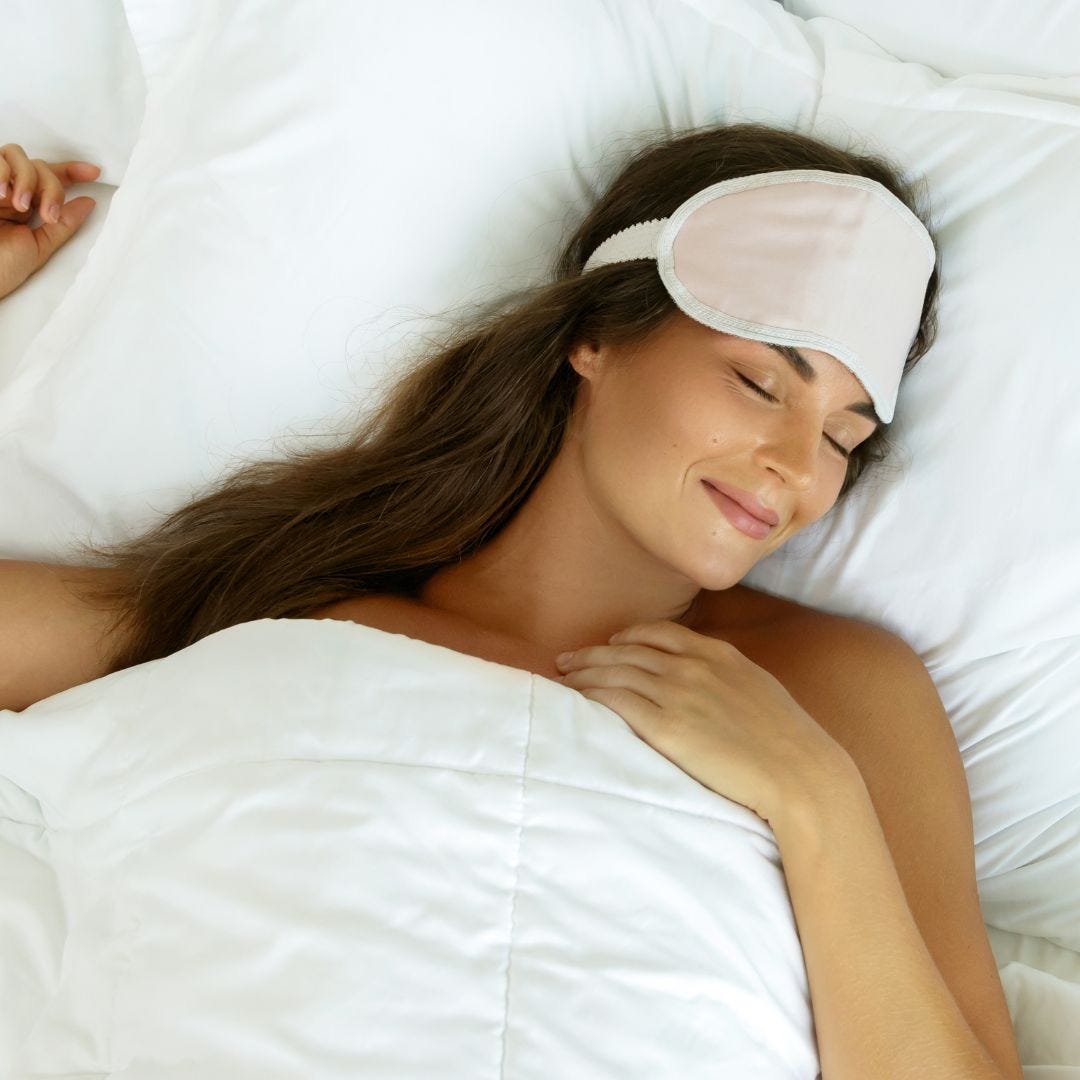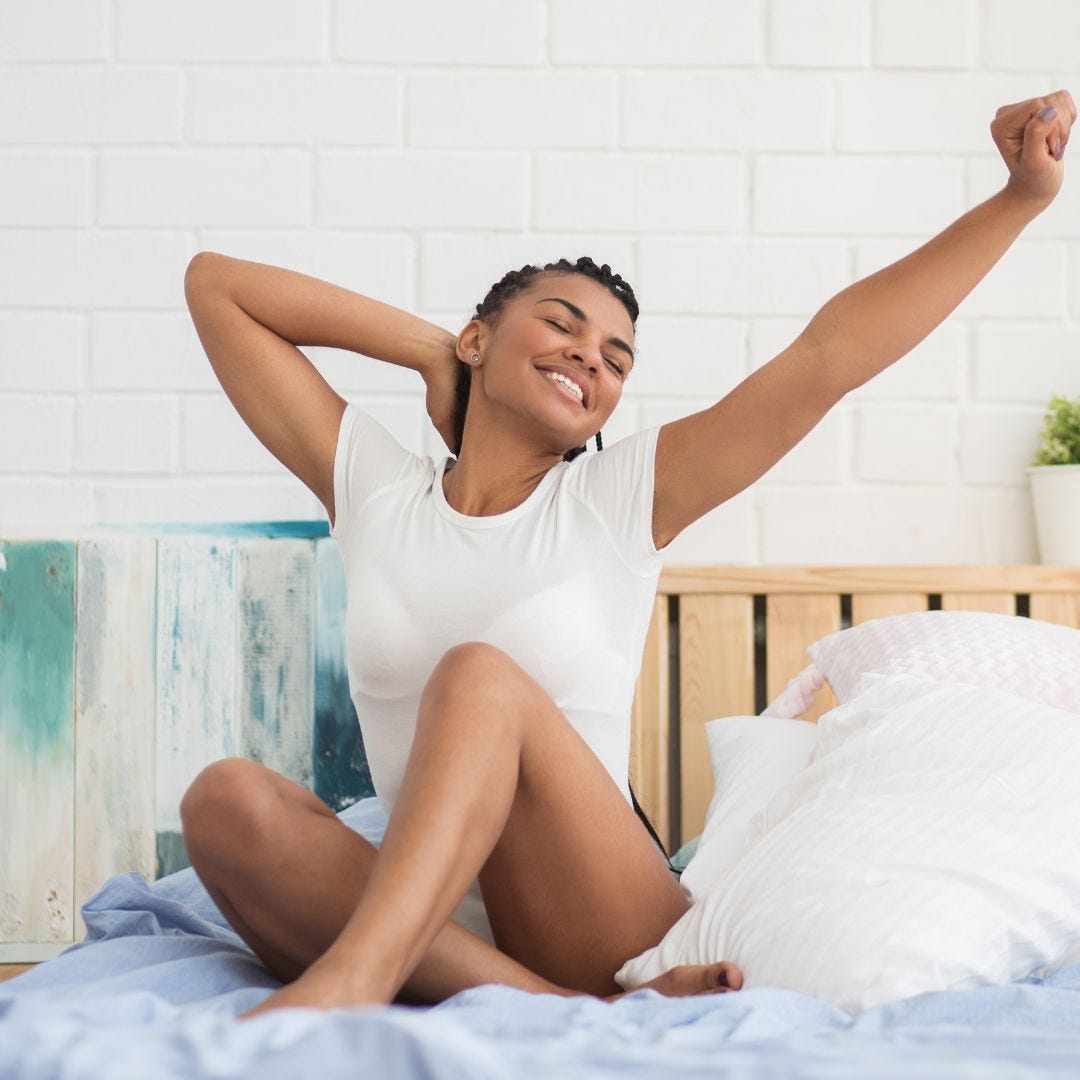If you're new here—welcome! And if you've been fanning yourself with us for a while, you know HOT FLASH! The Newsletter is where lifestyle wisdom meets evidence‑based insights to empower a thriving menopause journey…
This week, in honor of Better Sleep Month, we're shining a light on insomnia—one of the most frustrating and potentially disruptive changes that hits women harder than men, especially during menopause.
Let’s start with this: you’re not imagining it, and you’re definitely not alone. Research suggests that nearly half of women in the menopause transition report significant challenges with sleep. And not just falling asleep—staying asleep, returning to sleep, and feeling rested are all part of the picture.
💬 This topic lit up the chat during our recent Better Sleep Month EmBODY WELLshop, which made it clear: many of us are exhausted and looking for practical solutions for better sleep. (Missed the WELLshop? Register here for the Better Sleep EmBODY WELLshop replay.)
Here are the important facts we all should know:
✔️ Women—especially in midlife and beyond—are significantly more likely to experience insomnia than men.
✔️ Hormonal fluctuations and vasomotor changes like night sweats increase the likelihood of disrupted sleep during menopause.
✔️ Sleep disruption, in turn, can intensify how menopause is experienced—creating a feedback loop that makes other changes and the sleeplessness harder to manage.
Across this week’s featured studies (more below), one truth stands out: sleep disruption during menopause isn’t caused by just one thing. Hormonal and vasomotor changes like hot flashes, lead to mood shifts and sleep loss and these all interact to create a cycle that not only makes sleep harder, but amplifies other menopause challenges along the way.
But here’s the empowering part: each study confirms that the most effective way to break this cycle is to shift how we think about and approach sleep. That’s right: a cognitive behavioral approach isn’t just helpful, it’s the recommended gold standard for insomnia and, as such, is also the recommended first-line treatment for insomnia during menopause, even before hormone therapy or sleep medications.
It’s no coincidence this aligns perfectly with the HOT FLASH! menopause mindset:
✨ Changing with the change means changing the story we tell ourselves—and CBT-I gives us the tools to do exactly that.
Which leads us to the most important practical takeaway:
✔️ CBT-I should be the first treatment tried for insomnia—even when menopause is the trigger.
This week, you’ll learn:
🧠 The hormonal dance behind menopause-related insomnia
📊 Key findings from recent research on disrupted sleep during menopause
🤔 What CBT-I is and how it differs from general CBT
💡 What you can actually do to reclaim restful sleep, including CBT-I resources you can access right away
This post is fully unlocked—share it with a sister, daughter, or friend who’s tired of tossing and turning.
What’s behind these midnight wake-up calls?
We know from lived experience that menopause can scramble our sleep—but what does the science say about why it happens. Two main drivers often tag-team in the middle of the night:
Cascading hormonal fluctuations, including the decline of estrogen and progesterone, but also cortisol and melatonin, which play a vital role in regulating sleep architecture and our circadian rhythms.
Vasomotor changes (those hot flashes and night sweats), which act like internal alarms jolting us out of slumber, raising our core temperature along with increasing our heart rate and anxiety.
Estrogen and progesterone aren’t just reproductive hormones—they’re also deeply involved in temperature regulation, stress reactivity, and the body’s natural sleep-wake cycle. As their levels decline, not only does sleep becomes lighter, more fragmented, we become more vulnerable to the physical arousal caused by other changes such as night sweats or stress.
And what does the research say?
The research below confirms that CBT-I is an appropriate first-line treatment for insomnia, including when it's clearly linked to menopause-related changes. Keep reading for what each study tells us, and, in the next section, CBT-I resources for your toolkit to put to work today.
🧪 Chicken or Egg: Sleep Disruption and Menopausal Changes
A 2019 review published in Maturitas gives a narrative account of previous research on the diagnosis and management of sleep disorders in menopausal women. Its central message is that it's necessary to identify the specific causes and contributing factors behind sleep disruption—whether hot flashes, mood disorders, sleep apnea, or other medical conditions—in order to provide targeted, effective treatment. It recommends CBT-I for primary insomnia and MHT for insomnia driven by menopausal symptoms. However, because sleep disturbances and other menopausal changes can reinforce one another in a bidirectional loop—e.g. poor sleep increases hot flash severity, and hot flashes worsen sleep, the review supports the idea that CBT-I may be a worthwhile first step even when insomnia appears secondary—especially when sleep is the main concern.
🧪 Sleep Quality, Menopausal Changes and a Cliffhanger
A 2022 review in Gynecological and Reproductive Endocrinology & Metabolism highlights how the transition to menopause and post-menopause involves a wide spectrum of hormonal, health, and age-related changes that can significantly disrupt sleep quality. While hormonal and other medications may reduce menopausal discomfort and improve sleep for some, the authors caution that pharmacological treatments may come with side effects that outweigh the benefits—especially when used long term. To that end, they recommend non-pharmacological options as a promising starting point for addressing both sleep disturbances and vasomotor symptoms. In particular, CBT-I (Cognitive Behavioral Therapy for Insomnia) and PureCyTonin® (a specialized cytoplasmic pollen extract) are called out for their potential to improve both without the side effect burden. Bonus: the benefits may be amplified when paired with broader lifestyle changes—a Changing with the Change signature strategy. (We’ll share more about pollen extract in a future edition!)
🧪 Personalized Paths: One Proven Starting Point
A new 2024 review in the Journal of Clinical Medicine summarized current theories on why sleep is disrupted during the menopausal transition—including hormonal shifts—and emphasized that treatment should be individualized. The authors recommended that, in alignment with general insomnia guidelines, CBT-I should be the first-line treatment before exploring hormonal and medication options.
🧠 These findings reinforce what we say around here all the time: Changing with the change starts in the mind. It confirms that there are non-hormonal options to explore for menopause-related changes, including insomnia.
CBT-I* works by honoring the whole system and invites the power of the mind and how we relate to sleep itself to create a broader shift.
*Unlike general CBT, which focuses on emotional regulation and mental health conditions like anxiety or depression, CBT-I is laser-focused on sleep itself. It includes structured techniques like sleep restriction, stimulus control, and belief reframing—all designed to reset your brain’s relationship with sleep. And, with its laser focus, it’s typically completed in 4–8 sessions (vs open-ended like general CBT).
Key Takeaways: Better Sleep—Starting Tonight
These findings aren't here to frustrate you—they're here to inform you. Here are some key mindset and lifestyle takeaways to make changing with the change happen tonight.
1. Changing sleep behavior starts with changing beliefs.
Insomnia is often reinforced by the belief that we’re “just bad sleepers.” But research (and experience!) show that sleep is trainable. CBT-I helps reframe those beliefs, reduce anxiety about sleep, and reset unhelpful patterns.
🧠 Check out our mindset-focused Better Sleep edition of the Virtual Coach newsletter: “Any rest I get tonight will support me in some way.”
2. Before you medicate, mindset first.
Menopausal hormone therapy (MHT) can help with vasomotor changes—but for insomnia itself, the recommended first-line approach is CBT-I. It’s proven to be effective, drug-free, and works even when hormones are still shifting. Emotional regulation and nervous system support are just as important as temperature and hormone balance. 🤔Check out the CBT-I resources below to get started.
3. Make the “light” choice to support your sleep-wake rhythm.
Step outside for morning light. Dim the lights in the evening. Simple light cues help re-align your circadian rhythm, improving your body’s natural readiness for sleep.
🌞 Check out our rhythm-focused Better Sleep edition of the Virtual Coach newsletter: “Get back in sync with light and dark.”
4. You have options in the moment.
When you can’t fall back asleep, trying harder rarely helps. If you’re jolted awake with a night sweat or anxious thought, instead of trying to force sleep, redirect your focus with a body scan or grounding technique and turn to your body and your breath:
🛏 Body: Try a body scan and progressive relaxation meditation to gently settle your nervous system.
🌬 Breath: Use cyclic sighing to calm mental chatter and regulate stress.
Remember: When sleep eludes us during menopause, it isn’t just about hormones—or hot flashes—or mood. It’s the feedback loop among them all. But good news: targeting one piece of the cycle—thoughts (and beliefs) about sleep—can begin to shift the whole system.
“Sleep is the only thing you can’t try to do. The harder you try, the less likely it is to happen.”
**Are you ready for CBT-I support? Great news: There are a plethora of options available both online and in person. A few choice options:
The Mayo Clinic’s Patient Education Center offers a free, self-paced CBT-I course you can explore on your own starting today.
The Society of Behavioral Sleep Medicine has a directory of trained CBT-I providers. You can also ask your primary care provider, therapist, or sleep specialist if they offer—or can refer you to—CBT-I.
Drop us a line if you try CBT-I—or even just start by shifting the sleep story you tell yourself—and let us know what you notice. (And, remember to share the heat with someone looking for better sleep!) Your stories (and your shares) fuel the fires of HOT FLASH! The Newsletter.







